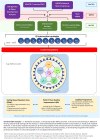Development of a framework of intervention strategies for point of care quality improvement at different levels of healthcare delivery system in India: initial lessons
- PMID: 34344739
- PMCID: PMC8336183
- DOI: 10.1136/bmjoq-2021-001449
Development of a framework of intervention strategies for point of care quality improvement at different levels of healthcare delivery system in India: initial lessons
Abstract
Background: Inadequate quality of care has been identified as one of the most significant challenges to achieving universal health coverage in low-income and middle-income countries. To address this WHO-SEARO, the point of care quality improvement (POCQI) method has been developed. This paper describes developing a dynamic framework for the implementation of POCQI across India from 2015 to 2020.
Methods: A total of 10 intervention strategies were designed as per the needs of the local health settings. These strategies were implemented across 10 states of India, using a modification of the 'translating research in practice' framework. Healthcare professionals and administrators were trained in POCQI using a combination of onsite and online training methods followed by coaching and mentoring support. The implementation strategy changed to a fully digital community of practice platform during the active phase of the COVID-19 pandemic. Dashboard process, outcome indicators and crude cost of implementation were collected and analysed across the implementation sites.
Results: Three implementation frameworks were evolved over the study period. The combined population benefitting from these interventions was 103 million. A pool of QI teams from 131 facilities successfully undertook 165 QI projects supported by a pool of 240 mentors over the study period. A total of 21 QI resources and 6 publications in peer-reviewed journals were also developed. The average cost of implementing POCQI initiatives for a target population of one million was US$ 3219. A total of 100 online activities were conducted over 6 months by the digital community of practice. The framework has recently extended digitally across the South-East Asian region.
Conclusion: The development of an implementation framework for POCQI is an essential requirement for the initiative's successful country-wide scale. The implementation plan should be flexible to the healthcare system's needs, target population and the implementing agency's capacity and amenable to multiple iterative changes.
Keywords: health services research; healthcare quality improvement; implementation science.
© Author(s) (or their employer(s)) 2021. Re-use permitted under CC BY. Published by BMJ.
Conflict of interest statement
Competing interests: RM is employed with the WHO-SEAR Office. He was responsible for the release of funds for some of the implementing strategies described in the paper. VS, VB are employed by UNICEF India and Madhya Pradesh field offices respectively, they were responsible for the release of funds for some of the implementing strategies described in the paper.The funding agencies had no bearing on methodology, data collection, data analysis and results reported in this paper. The opinions expressed herein are those of the authors and do not necessarily represent the official views of the WHO or UNICEF.
Figures





References
MeSH terms
Grants and funding
LinkOut - more resources
Full Text Sources
Medical
